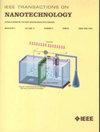CMOS-RRAM Based Non-Volatile Ternary Content Addressable Memory (nvTCAM)
IF 2.1
4区 工程技术
Q3 ENGINEERING, ELECTRICAL & ELECTRONIC
引用次数: 0
Abstract
We propose a Non-Volatile Ternary Content Addressable Memory (nvTCAM) by utilizing two Resistive Random-Access Memory (RRAM) cells integrated with individual selector transistors (i.e., 2-Transistor, 2-RRAM). A 2T2R cell configured either in complementary resistive switching mode (i.e., if one 1T1R cell is in low resistance state then the other cell will be in high resistance state or vice-versa) or both RRAMs in high resistance state is utilized to implement a single nvTCAM unit. Through Monte-Carlo (MC) simulations and power supply scaling (i.e.,基于 CMOS-RRAM 的非易失性三元内容可寻址存储器 (nvTCAM)
我们提出了一种非易失性三元内容可寻址存储器(nvTCAM),它利用两个与单独选择晶体管集成的电阻式随机存取存储器(RRAM)单元(即 2 晶体管、2-RRAM)。2T2R 单元配置为互补电阻开关模式(即如果一个 1T1R 单元处于低电阻状态,则另一个单元将处于高电阻状态,反之亦然),或者两个 RRAM 均处于高电阻状态,从而实现单个 nvTCAM 单元。通过蒙特卡洛(Monte-Carlo,MC)模拟和电源扩展(即 $V_{DD}$ 从 1.4 V 变化到 2.2 V)效应,我们研究了所提单元的可靠性。此外,我们还对从 1 位到 64 位的各种字长进行了模拟,并计算了能量和延迟参数。我们将提出的 nvTCAM 单元与现有的各种 CMOS/NVM(非易失性存储器)设计进行了比较。与CMOS-NVM相比,我们提出的nvTCAM设计节省了2倍的面积,与基于CMOS的易失性TCAM相比,甚至节省了6倍的面积。与现有的 CMOS/RRAM 实现相比,所提出的设计实现了至少 1.68 倍到 2.27 倍的能效。此外,与基于磁/铁电的 nvTCAM 相比,节能效果进一步提高到 1400 倍。
本文章由计算机程序翻译,如有差异,请以英文原文为准。
求助全文
约1分钟内获得全文
求助全文
来源期刊

IEEE Transactions on Nanotechnology
工程技术-材料科学:综合
CiteScore
4.80
自引率
8.30%
发文量
74
审稿时长
8.3 months
期刊介绍:
The IEEE Transactions on Nanotechnology is devoted to the publication of manuscripts of archival value in the general area of nanotechnology, which is rapidly emerging as one of the fastest growing and most promising new technological developments for the next generation and beyond.
 求助内容:
求助内容: 应助结果提醒方式:
应助结果提醒方式:


